Python 字节码与字节码混淆
Python 字节码
- 虽然 Python 作为解释型语言,但是其也不是直接对源代码进行解释
- Python 解释器会将源代码处理成字节码后,借助 Python 解释器运行程序
- 通过 Python 自带的模块 dis 可以将目标函数转换成字节码
import dis
def fun(x, y, z):
a = 1
a += 1
print("aaa")
fun(1, 2, 3)
return
dis.dis(fun)
- 控制台输出内容如下
- 第一列对应的是源代码中的行号
- 第二列对应的是源代码转化成的字节码
- 第三列为此次操作对应的值(括号内为具体值)
- 例如第六行
- 解释器先读取了全局对象
print函数,推入程序栈 - 程序又将字符串
'aaa'推入程序栈 - 调用函数,并解释只有 1 个变量,解释器便会将栈顶的 1 个变量传递给函数,然后调用函数
- 需要注意,如果有多个参数的话,参数入栈顺序是从左到右,也就是最右边的参数在最顶端
CALL_FUNCTION会在结束后弹出栈顶对应参数数量的元素,但是函数不会被弹出栈,因此最后有一个POP_TOP
- 解释器先读取了全局对象
> python3 -u "/Users/biox/NutStore/Codes/VSCode/python/py1.py"
4 0 LOAD_CONST 1 (1)
2 STORE_FAST 3 (a)
5 4 LOAD_FAST 3 (a)
6 LOAD_CONST 1 (1)
8 INPLACE_ADD
10 STORE_FAST 3 (a)
6 12 LOAD_GLOBAL 0 (print)
14 LOAD_CONST 2 ('aaa')
16 CALL_FUNCTION 1
18 POP_TOP
7 20 LOAD_GLOBAL 1 (fun)
22 LOAD_CONST 1 (1)
24 LOAD_CONST 3 (2)
26 LOAD_CONST 4 (3)
28 CALL_FUNCTION 3
30 POP_TOP
8 32 LOAD_CONST 0 (None)
34 RETURN_VALUE
常见指令
-
详细内容见官方文档
-
一般指令与一元操作指令
| 指令 | 作用 |
|---|---|
| NOP | 无作用,用于占位 |
| POP_TOP | 弹出栈顶元素 |
| LOAD_CONST | 将读取的值推入栈 |
| LOAD_GLOBAL | 将全局变量对象压入栈顶 |
| STORE_FAST | 将栈顶指令存入对应局部变量 |
| COMPARE_OP | 比较操作符 |
| CALL_FUNCTION | 调用函数 |
| BUILD_SLICE | 调用切片,跟的参数为切片的值的个数,一般从上到下为 [Val1:Val2:Val3] |
| JUMP_ABSOLUTE | 向下跳转几句操作符,变量为跳转偏移量 |
| UNARY_POSITIVE | 实现 Val1 = +Val1 |
| UNARY_NEGATIVE | 实现 Val1 = -Val1 |
| UNARY_NOT | 实现 Val1 = not Val1 |
| UNARY_INVERT | 实现 Val1 = ~Val |
| FOR_ITER | for 循环 |
| GET_ITER | 获取迭代器(一般后面跟循环) |
| GET_YIELD_FROM_ITER | 获取 yield 生成器 |
- 二元操作指令
| 指令 | 作用 |
|---|---|
| BINARY_POWER | 乘方,栈顶数为指数 |
| BINARY_MULTIPLY | 乘法 |
| BINARY_MATRIX_MULTIPLY | 矩阵乘法,3.5 引入的新功能 |
| BINARY_FLOOR_DIVIDE | 除法,结果向下取整 |
| BINARY_TRUE_DIVIDE | 除法 |
| BINARY_MODULO | 取余 |
| BINARY_ADD | 加法 |
| BINARY_SUBTRACT | 减法 |
| BINARY_SUBSCR | 数组取下标,栈顶为下标 |
| BINARY_LSHIFT | 左移操作符(乘2) |
| BINARY_RSHIFT | 右移操作符(除2向下取整) |
| BINARY_AND | 按位与 |
| BINARY_XOR | 异或 |
| BINARY_OR | 按位或 |
| STORE_SUBSCR | 列表下标存储,例如 Val1[Val2] = Val3 |
| DELETE_SUBSCR | 按下标删除元素,例如 del Val1[Val2] |
-
自身操作指令,类似
b += 1,就是上方有 BINARY 的指令的 BINARY 改成 INPLACE -
其他指令见官方文档
Pyc 文件解析
- Pyc 文件是 PythonCodeObject 对象的持久化保存方式
- 有时候会见到 Pyo 文件,这个是经过 Python 解释器优化后生成的字节码
- 这个优化只是缩小了文件的体积,在代码运行速度上和 Pyc 差不多
- 尤其对于被 import 的文件,Python 解释器为了加快下一次被引用文件的读取速度,都会生成一个对应的 Pyc 文件
- 当后续被 import 的时候,解释器会优先寻找持久化存储的对象
- 在 Python 源代码运行的时候,Python 解释器会先将代码处理成 PythonCodeObject 对象,保存在内存中处理
- 除去预处理 PythonCodeObject 对象的过程,在执行速度上 Pyc 文件、Pyo 文件和源代码文件的速度相差无几
- 需要注意的是,Pyc 文件只能运行在生成出此文件的解释器版本上
- Python 在生成 Pyc 文件的时候也引入了 MagicNumber,来标示此 Pyc 文件对应的版本号
- 在 Python 解释器目录下
./lib/python3.7/importlib/_bootstrap-external.py中有明确的版本号记录- 这里的版本号是解释器字节码更新的版本号
# Magic word to reject .pyc files generated by other Python versions.
# It should change for each incompatible change to the bytecode.
#
# The value of CR and LF is incorporated so if you ever read or write
# a .pyc file in text mode the magic number will be wrong; also, the
# Apple MPW compiler swaps their values, botching string constants.
#
# There were a variety of old schemes for setting the magic number.
# The current working scheme is to increment the previous value by
# 10.
#
# Starting with the adoption of PEP 3147 in Python 3.2, every bump in magic
# number also includes a new "magic tag", i.e. a human readable string used
# to represent the magic number in __pycache__ directories. When you change
# the magic number, you must also set a new unique magic tag. Generally this
# can be named after the Python major version of the magic number bump, but
# it can really be anything, as long as it's different than anything else
# that's come before. The tags are included in the following table, starting
# with Python 3.2a0.
#
# Known values:
# Python 1.5: 20121
# Python 1.5.1: 20121
# Python 1.5.2: 20121
# Python 1.6: 50428
# Python 2.0: 50823
# Python 2.0.1: 50823
# Python 2.1: 60202
# Python 2.1.1: 60202
# Python 2.1.2: 60202
# Python 2.2: 60717
# Python 2.3a0: 62011
# Python 2.3a0: 62021
# Python 2.3a0: 62011 (!)
# Python 2.4a0: 62041
# Python 2.4a3: 62051
# Python 2.4b1: 62061
# Python 2.5a0: 62071
# Python 2.5a0: 62081 (ast-branch)
# Python 2.5a0: 62091 (with)
# Python 2.5a0: 62092 (changed WITH_CLEANUP opcode)
# Python 2.5b3: 62101 (fix wrong code: for x, in ...)
# Python 2.5b3: 62111 (fix wrong code: x += yield)
# Python 2.5c1: 62121 (fix wrong lnotab with for loops and
# storing constants that should have been removed)
# Python 2.5c2: 62131 (fix wrong code: for x, in ... in listcomp/genexp)
# Python 2.6a0: 62151 (peephole optimizations and STORE_MAP opcode)
# Python 2.6a1: 62161 (WITH_CLEANUP optimization)
# Python 2.7a0: 62171 (optimize list comprehensions/change LIST_APPEND)
# Python 2.7a0: 62181 (optimize conditional branches:
# introduce POP_JUMP_IF_FALSE and POP_JUMP_IF_TRUE)
# Python 2.7a0 62191 (introduce SETUP_WITH)
# Python 2.7a0 62201 (introduce BUILD_SET)
# Python 2.7a0 62211 (introduce MAP_ADD and SET_ADD)
# Python 3000: 3000
# 3010 (removed UNARY_CONVERT)
# 3020 (added BUILD_SET)
# 3030 (added keyword-only parameters)
# 3040 (added signature annotations)
# 3050 (print becomes a function)
# 3060 (PEP 3115 metaclass syntax)
# 3061 (string literals become unicode)
# 3071 (PEP 3109 raise changes)
# 3081 (PEP 3137 make __file__ and __name__ unicode)
# 3091 (kill str8 interning)
# 3101 (merge from 2.6a0, see 62151)
# 3103 (__file__ points to source file)
# Python 3.0a4: 3111 (WITH_CLEANUP optimization).
# Python 3.0b1: 3131 (lexical exception stacking, including POP_EXCEPT
#3021)
# Python 3.1a1: 3141 (optimize list, set and dict comprehensions:
# change LIST_APPEND and SET_ADD, add MAP_ADD #2183)
# Python 3.1a1: 3151 (optimize conditional branches:
# introduce POP_JUMP_IF_FALSE and POP_JUMP_IF_TRUE
#4715)
# Python 3.2a1: 3160 (add SETUP_WITH #6101)
# tag: cpython-32
# Python 3.2a2: 3170 (add DUP_TOP_TWO, remove DUP_TOPX and ROT_FOUR #9225)
# tag: cpython-32
# Python 3.2a3 3180 (add DELETE_DEREF #4617)
# Python 3.3a1 3190 (__class__ super closure changed)
# Python 3.3a1 3200 (PEP 3155 __qualname__ added #13448)
# Python 3.3a1 3210 (added size modulo 2**32 to the pyc header #13645)
# Python 3.3a2 3220 (changed PEP 380 implementation #14230)
# Python 3.3a4 3230 (revert changes to implicit __class__ closure #14857)
# Python 3.4a1 3250 (evaluate positional default arguments before
# keyword-only defaults #16967)
# Python 3.4a1 3260 (add LOAD_CLASSDEREF; allow locals of class to override
# free vars #17853)
# Python 3.4a1 3270 (various tweaks to the __class__ closure #12370)
# Python 3.4a1 3280 (remove implicit class argument)
# Python 3.4a4 3290 (changes to __qualname__ computation #19301)
# Python 3.4a4 3300 (more changes to __qualname__ computation #19301)
# Python 3.4rc2 3310 (alter __qualname__ computation #20625)
# Python 3.5a1 3320 (PEP 465: Matrix multiplication operator #21176)
# Python 3.5b1 3330 (PEP 448: Additional Unpacking Generalizations #2292)
# Python 3.5b2 3340 (fix dictionary display evaluation order #11205)
# Python 3.5b3 3350 (add GET_YIELD_FROM_ITER opcode #24400)
# Python 3.5.2 3351 (fix BUILD_MAP_UNPACK_WITH_CALL opcode #27286)
# Python 3.6a0 3360 (add FORMAT_VALUE opcode #25483)
# Python 3.6a1 3361 (lineno delta of code.co_lnotab becomes signed #26107)
# Python 3.6a2 3370 (16 bit wordcode #26647)
# Python 3.6a2 3371 (add BUILD_CONST_KEY_MAP opcode #27140)
# Python 3.6a2 3372 (MAKE_FUNCTION simplification, remove MAKE_CLOSURE
# #27095)
# Python 3.6b1 3373 (add BUILD_STRING opcode #27078)
# Python 3.6b1 3375 (add SETUP_ANNOTATIONS and STORE_ANNOTATION opcodes
# #27985)
# Python 3.6b1 3376 (simplify CALL_FUNCTIONs & BUILD_MAP_UNPACK_WITH_CALL
#27213)
# Python 3.6b1 3377 (set __class__ cell from type.__new__ #23722)
# Python 3.6b2 3378 (add BUILD_TUPLE_UNPACK_WITH_CALL #28257)
# Python 3.6rc1 3379 (more thorough __class__ validation #23722)
# Python 3.7a1 3390 (add LOAD_METHOD and CALL_METHOD opcodes #26110)
# Python 3.7a2 3391 (update GET_AITER #31709)
# Python 3.7a4 3392 (PEP 552: Deterministic pycs #31650)
# Python 3.7b1 3393 (remove STORE_ANNOTATION opcode #32550)
# Python 3.7b5 3394 (restored docstring as the first stmt in the body;
# this might affected the first line number #32911)
#
# MAGIC must change whenever the bytecode emitted by the compiler may no
# longer be understood by older implementations of the eval loop (usually
# due to the addition of new opcodes).
#
# Whenever MAGIC_NUMBER is changed, the ranges in the magic_values array
# in PC/launcher.c must also be updated.
- 对于 pyc 文件整体的 C 结构体,可以在
./include/python2.7/code.h或不同版本类似的文件中找到- 具体代码如下
/* Bytecode object */
typedef struct {
PyObject_HEAD
int co_argcount; /* #arguments, except *args */
int co_nlocals; /* #local variables */
int co_stacksize; /* #entries needed for evaluation stack */
int co_flags; /* CO_..., see below */
PyObject *co_code; /* instruction opcodes */
PyObject *co_consts; /* list (constants used) */
PyObject *co_names; /* list of strings (names used) */
PyObject *co_varnames; /* tuple of strings (local variable names) */
PyObject *co_freevars; /* tuple of strings (free variable names) */
PyObject *co_cellvars; /* tuple of strings (cell variable names) */
/* The rest doesn't count for hash/cmp */
PyObject *co_filename; /* string (where it was loaded from) */
PyObject *co_name; /* string (name, for reference) */
int co_firstlineno; /* first source line number */
PyObject *co_lnotab; /* string (encoding addr<->lineno mapping) See
Objects/lnotab_notes.txt for details. */
void *co_zombieframe; /* for optimization only (see frameobject.c) */
PyObject *co_weakreflist; /* to support weakrefs to code objects */
} PyCodeObject;
- 将 Python 源代码生成为 Pyc 文件,这里使用的版本是 Python 2.7.6
- 这里我们将一个名为
py1.py的文件
- 这里我们将一个名为
import py_compile
py_compile.compile('./py1.py')
- 会在源代码文件目录下找到编译后的文件
- 使用 010 editor 打开,会提示是否需要安装 pyc 字节码辅助插件,虽然说只支持 2.4 - 2.7
- Python 3 以后的都不能用…
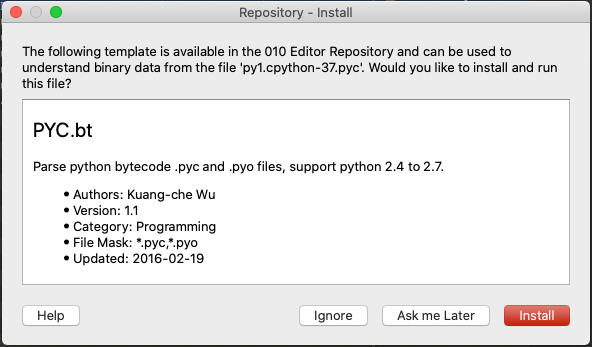
- 此处以中南大学2020校赛的一道逆向题目 py&flower.pyc 作为介绍,使用 010 editor 打开
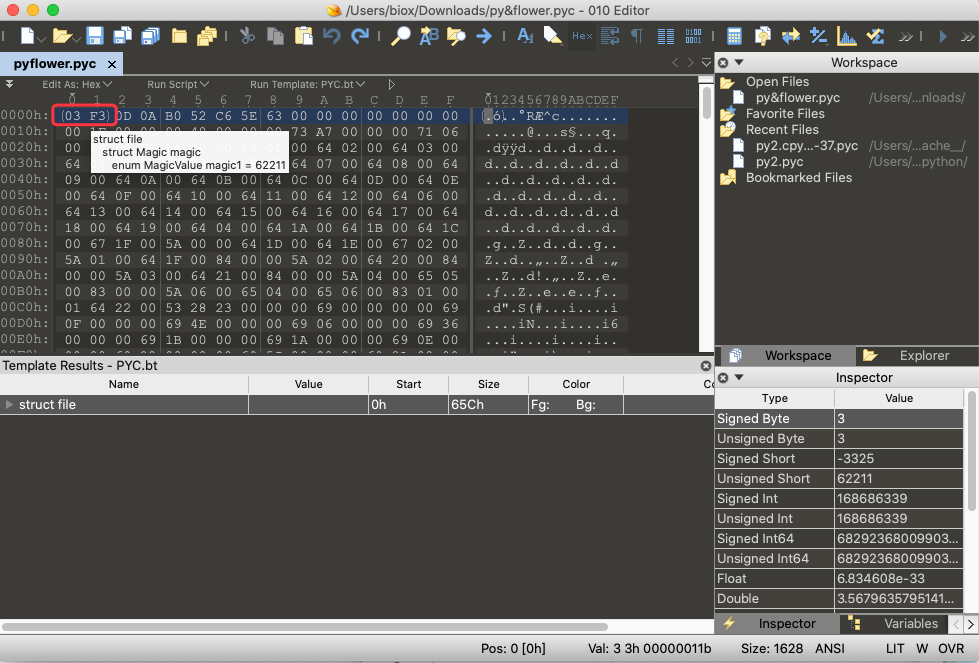
-
最前面的 4 个字节为 Magic Number ,其中前两个直接为解释器的版本号
- 此处前两个字节为 62211,也就是 Python 2.7.0a0 版本的字节码解释器
- 注意这里是小端序,就是高位在后面,所以是 0xF303
-
Magic Number 之后的四个字节为时间戳,这里是 0x5EC652B0,之后就是 Python 代码对象
-
代码对象首先一个字节表示此处的对象类型,这里值为 TYPE_CODE,值为 0x63,
-
此后四个字节表示参数的个数,也就是 co_argcount 的值
-
往后四个字节是局部变量的个数 co_nlocals
-
往后四个字节是栈空间大小 co_stacksize
-
往后四个字节是 co_flags
-
之后就是 co_code 了,也就是编译好的字节码的部分
- co_code 部分首先的一个字节也是表示此处的对象类型,这里是 TYPE_STRING,为 0x73
- 接下来四个字节表示此 co_code 对象的长度,此后就是代码对象,这里的代码长度为 0xA7
- 也就是后方 163 个字节的长度都是代码对象
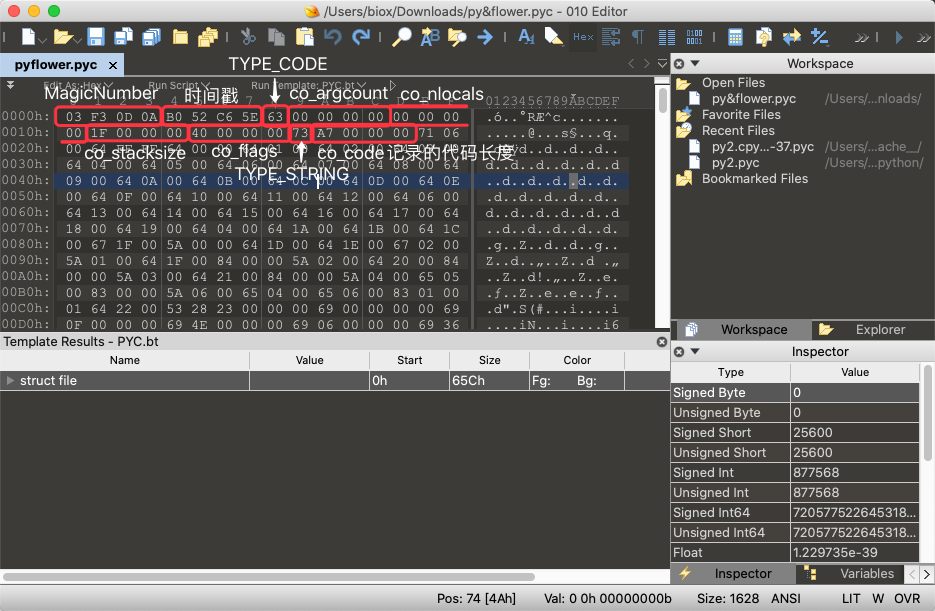
- 此 co_code 对象的字节码内容结束后,接着是 co_consts 内容,也就是用到的常量的内容
- 最开始是 TYPE_TUPLE,表示这是个元组类型
- 此后四个字节是元素个数,这里是 0x23,之后每一个字节与对应的值一组,一共 0x23 组
- 每组中第一个字节表示元素类型,比如 0x69 指 TYPE_INT,此后为对应的值
- 后方也对应结构体中的相应内容

字节码混淆
Anti-uncompyle6
- 对于正常的 pyc 文件,使用 uncompyle6 插件可以正常的进行字节码逆向,得到原来的代码
> uncompyle6 ./py2.pyc
- 如果需要使 uncompyle6 失效的话,只要在 co_code 头部加上
0x71 0x03 0x00,然后把记录 co_code 长度的数据加 3- 这段字节码指
JUMP_ABSOLUTE 3,也就是向后跳 3 个字节后继续执行,实际上没有改变代码逻辑 - 但是 uncompyle6 插件的还原逻辑就没办法识别此字节码原先的意思,导致解析异常
- 这段字节码指
Anti-dis
- 上文的改法会导致 uncompyle6 插件异常,但是这个方法的实质只是增加了一句字节码
- Python 可以借助自带的 dis 库和 marshal 库解析 pyc 二进制文件中的信息,此处以一个简单的代码作为例子
def fun1():
enc = "Ua`|{f.4V}$l4h4Vx{s.4|``dg.;;vx{s:v}$l:wz;4h4Dxqugq4}zp}wu`q4`|q4g{afwq4ur`qf4m{af4pqf}bu`}{z"
flag = ""
for i in enc:
flag += chr(ord(i) ^ 0x14)
print flag
fun1()
- 编译成 pyc 文件后,尝试加入
JUMP_ABSOLUTE 3到代码头部- 橙色的字节为编辑过的

- 使用 uncompyle6 发生 Parse error 异常,但是还是可以正常运行
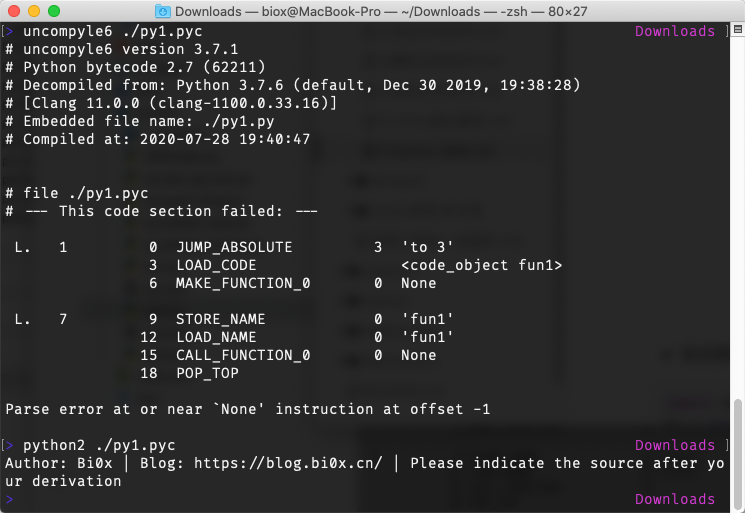
- 尝试使用 marshal 模块搭配 dis 模块进行字节码解析
import marshal, dis
fp = open("./py1.pyc")
fp.read(8) # Read out magic number and timestamp
co_code = marshal.load(fp)
dis.dis(co_code)
- 程序输出了完整的字节码,根据字节码还是可以顺利的还原出源代码信息
- 可以发现,头部已经加上了我们自己编辑的
JUMP_ABSOLUTE 3
- 可以发现,头部已经加上了我们自己编辑的
> python2 -u "/Users/biox/NutStore/Codes/VSCode/python/py2.py"
1 0 JUMP_ABSOLUTE 3
>> 3 LOAD_CONST 0 (<code object fun1 at 0x1010486b0, file "./py1.py", line 1>)
6 MAKE_FUNCTION 0
7 9 STORE_NAME 0 (fun1)
12 LOAD_NAME 0 (fun1)
15 CALL_FUNCTION 0
18 POP_TOP
19 LOAD_CONST 1 (None)
22 RETURN_VALUE
- 如果我们不想让 dis 顺利的导出字节码,也可以用一些指令来使得 dis 模块产生异常
- 比如来个指令重叠,中间插一个读取数据的字节码
0x71 0x04 0x00 0x64 0x71 0x08 0x00 0x00 - 这里的
0x64为解释器的 LOAD_CONST 指令,如果正常的话这里应该是LOAD_CONST 0x0871 - 那么 dis 模块就看不懂了,实际上通过前面的
0x71 0x04 0x00会跳过此字节码,实际上是不执行的 - 后方的
0x71 0x08 0x00是根据前面第一个0x71开始跳转的,所以跟的是0x08
- 比如来个指令重叠,中间插一个读取数据的字节码
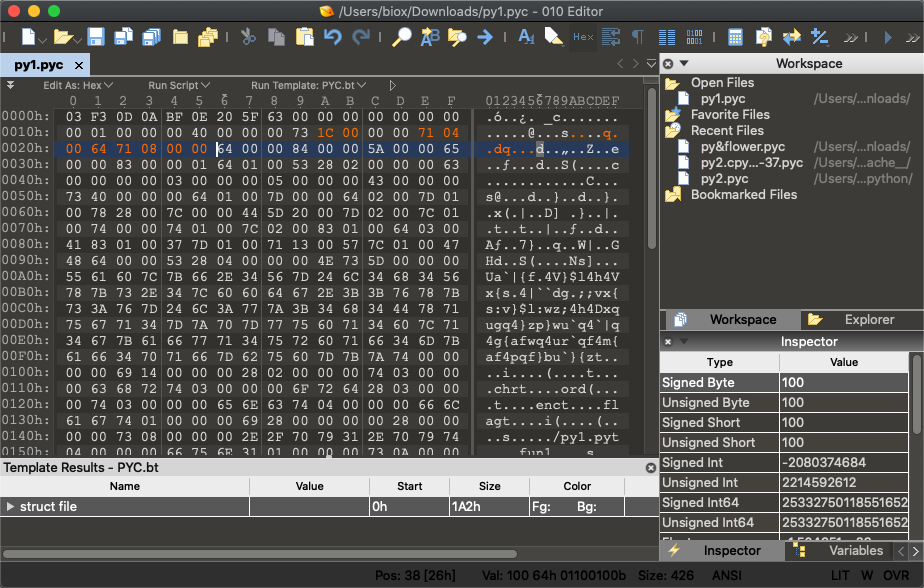
- 尝试 dis 字节码,直接抛出 IndexError 了,同时 uncompyle6 也 IndexError 了
> python2 -u "/Users/biox/NutStore/Codes/VSCode/python/py2.py" python
1 0 JUMP_ABSOLUTE 4
3 LOAD_CONST 2161
Traceback (most recent call last):
File "/Users/biox/NutStore/Codes/VSCode/python/py2.py", line 5, in <module>
dis.dis(co_code)
File "/usr/local/Cellar/python@2/2.7.16_1/Frameworks/Python.framework/Versions/2.7/lib/python2.7/dis.py", line 43, in dis
disassemble(x)
File "/usr/local/Cellar/python@2/2.7.16_1/Frameworks/Python.framework/Versions/2.7/lib/python2.7/dis.py", line 98, in disassemble
print '(' + repr(co.co_consts[oparg]) + ')',
IndexError: tuple index out of range
- 如果需要还原成能正常 dis 的 pyc 文件,只能手动修补了
动态创建内置类型
- Python 还有一个自带的库,叫做 types,借助这个库可以生成 Python 内置的类型
- 比如生成 code 对象,这里以 2020 年 XCTF-CyBRICS 逆向 Ployglot 为例,其最后一层逆向的 Python 代码就是用了此方法
import types
def define_func(argcount, nlocals, code, consts, names):
#PYTHON3.8!!!
def inner():
return 0
fn_code = inner.__code__
cd_new = types.CodeType(argcount,
0,
fn_code.co_kwonlyargcount,
nlocals,
1024,
fn_code.co_flags,
code,
consts,
names,
tuple(["v%d" for i in range(nlocals)]),
fn_code.co_filename,
fn_code.co_name,
fn_code.co_firstlineno,
fn_code.co_lnotab,
fn_code.co_freevars,
fn_code.co_cellvars)
inner.__code__ = cd_new
return inner
f1 = define_func(2,2,b'|\x00|\x01k\x02S\x00', (None,), ())
f2 = define_func(1,1,b't\x00|\x00\x83\x01S\x00', (None,), ('ord',))
f3 = define_func(0,0,b't\x00d\x01\x83\x01S\x00', (None, 'Give me flag: '), ('input',))
f4 = define_func(1, 3, b'd\x01d\x02d\x03d\x04d\x05d\x01d\x06d\x07d\x08d\td\x03d\nd\x0bd\x0cd\rd\x08d\x0cd\x0ed\x0cd\x0fd\x0ed\x10d\x11d\td\x12d\x03d\x10d\x03d\x0ed\x13d\x0bd\nd\x14d\x08d\x13d\x01d\x01d\nd\td\x01d\x12d\x0bd\x10d\x0fd\x14d\x03d\x0bd\x15d\x16g1}\x01t\x00|\x00\x83\x01t\x00|\x01\x83\x01k\x03r\x82t\x01d\x17\x83\x01\x01\x00d\x18S\x00t\x02|\x00|\x01\x83\x02D\x00]$}\x02t\x03|\x02d\x19\x19\x00t\x04|\x02d\x1a\x19\x00\x83\x01\x83\x02d\x18k\x02r\x8c\x01\x00d\x18S\x00q\x8cd\x1bS\x00',
(None, 99, 121, 98, 114, 105, 115, 123, 52, 97, 100, 51, 101, 55, 57, 53, 54, 48, 49, 50, 56, 102, 125, 'Length mismatch!', False, 1, 0, True),
('len', 'print', 'zip', 'f1', 'f2'))
f5 = define_func(0, 1,b't\x00\x83\x00}\x00t\x01|\x00\x83\x01d\x01k\x08r\x1ct\x02d\x02\x83\x01\x01\x00n\x08t\x02d\x03\x83\x01\x01\x00d\x00S\x00',(None, False, 'Nope!', 'Yep!'), ('f3', 'f4', 'print'))
f5()
- 使用给定的字节码,构造 CodeType 对象,直接转换成函数来调用
- 只要把对应的 PyCodeObject 中应该有的值构造正确,就能顺利执行
- 这样的函数如果没加花指令,是可以直接 dis 出来的
如有错误,欢迎师傅们指正






















 384
384











 被折叠的 条评论
为什么被折叠?
被折叠的 条评论
为什么被折叠?








